What is a Governance, Risk and Compliance (GRC) culture?
Before adopting new technologies, companies must train their teams and stabilize its corporate governance, the risk management and compliance. This must become a culture for all areas of the company. It would not make sense to reinforce corporate governance, risk management and regulatory compliance just to comply with legal requirements if there is no organizational culture that aligns these three aspects … Read more

